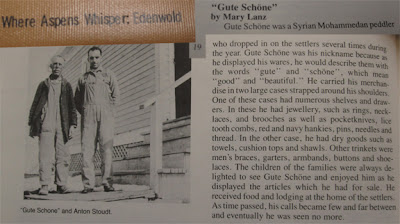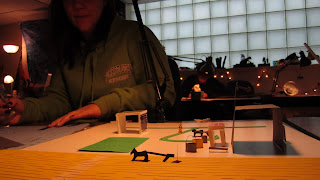I wish we knew what his real name was.
What I have already learned is that Syrian peddlers were quite common in Canada in the early days of settlement, and that they were mostly from the area of old Syria that is now Lebanon.
Here are a few reference images of traditional Syrian male dress from around 1910, and earlier. Granted, the Syria of 1910 included what is now Lebanon, Palestine, and modern Syria, so it would be quite easy to get lost in researching tiny cultural details; for this and other reasons I don't want to get too strongly attached to any of these images, but definitely want to keep them on hand to reference in terms of colour, texture, and flavour.
A Syrian colony in New York, 1910
A Syrian soft-drink seller, New York, circa 1910
contemporary men in traditional Syrian dress
ABOVE: Syrian peddlers in the United States:
Left: Kalil Michwee, circa 1917, Southern U.S., Courtesy of the Birmingham Library
Right: Syrian-American peddler Ferris Skaff with a customer in rural North Dakota, 1910
Right: Syrian-American peddler Ferris Skaff with a customer in rural North Dakota, 1910
It's interesting that Kalil on the left has pretty much adopted Western dress, while Ferris on the right seems to maintain some aspects of Syrian dress in the cut of his clothing and his silhouette -- and the New York Syrians above seem to be quite substantially un-Westernized.
Above and below: various images of antique Syrian boxes
What is of note is that the visits paid by these traveling peddlers were high points in the lives of the settlers. Imagine a traveling store coming to your prairie homestead, stocked not only with essentials (such as lice tooth combs) but also, according to some other accounts, with exotic items such as laces and perfumes from the Middle East.
I have decided to make Gute Schöne a somewhat magical character, to interpret him in a way through the eyes of a Saskatchewan farmer's child, and to try to create a sense of the faraway, exotic country that the homesteaders might imagine he is from. To this end, I am interested in bringing in some other elements of Gute Schöne's cultural heritage in terms of design as well, such as allowing various Syrian motifs to influence his boxes and the look and feel of his costume.
I have decided to make Gute Schöne a somewhat magical character, to interpret him in a way through the eyes of a Saskatchewan farmer's child, and to try to create a sense of the faraway, exotic country that the homesteaders might imagine he is from. To this end, I am interested in bringing in some other elements of Gute Schöne's cultural heritage in terms of design as well, such as allowing various Syrian motifs to influence his boxes and the look and feel of his costume.
Several elements will help with helping to define these aspects of the character; while I don't want him to come sweeping in on a flying carpet, we are looking at ways of making the cut of his Canadian clothing subtly resemble that of merchants in Syria at the time; for example, instead of an actual fez, he might be wearing an engineer's type cap, which has folded itself into a shape reminiscent of a fez, without quite being a fez.
Preproduction and Testing:
Aerial Shot Dimensions test
Aerial Shot Dimensions test
tackled by Noelle Duddrige, Emily Berntson
(with tips from Sarah Huber and Berny Hi)
(with tips from Sarah Huber and Berny Hi)
Emily and Noelle got right to work laying out a quick mock-up of the homestead set and shooting a few tests with our miniature crane, mounted on a three-wheeled tripod dolly.
As rough as this test is, it gives us a pretty good idea of just how much extra room we'll need to dress all around the actual set. How much would a helicopter shot cost over a real vintage homestead? This will hopefully be cheaper.
Meanwhile, in the concept department, we discussed options for the design of the farm family (a husband and wife with two children, and another man, probably the wife's brother), as well as the look of the farm, which I am considering building out of found objects, and of course, the character design for Gute Schöne and his mysterious boxes as well.
The next step is colour! Here's a first pass at a possible colour palette for Gute Schöne, although of course his palette will largely depend on the palette of the surrounding environment and characters, as I want to emphasize him in several ways, one of which will most certainly be by contrasting his colour palette against that of the rest of the world.
Meanwhile, back at the farm, Noelle and Emily got to work fleshing out a miniature of our aerial set. Metric is hard!!!
Noelle gathered a good deal of source material for the set from various archival resources, and collected her findings in these wonderful amalgamations:
Noelle gathered a good deal of source material for the set from various archival resources, and collected her findings in these wonderful amalgamations:
Thanks for going above and beyond, Noelle! You rock.
"Metric is hard."
"Hm, on second thought, it's not the metric that's hard.
It's the conversion from Imperial."
It's the conversion from Imperial."
By the end of our second day of camera tests and preproduction we had a test shot flying through with the miniature set, using diffusion over a desk lamp for the flat late afternoon light and an orange gel over a clamp light for the parting of the clouds for Magic Hour. This clip was shot hastily at the end of the day using a small still camera, handheld. As rough as it is, this gives us a ton of information.
Collaborators on the Gute Schöne film project include three Fine Arts students from the University of Regina, which has graciously partnered with This Big World as part of the Professional Placement program: Noelle Duddridge and Emily Berntson (Media Production and Studies) and Quin Greig (Sculpture BFA in Visual Arts).
and last but not least, filling several roles from co-producing to cinematography, editing, and everything in between, is the Filmpool's own Berny Hi.
until next time...
puppetz rule!
After the two-part plaster mold was cured, I poured a test-head out of latex to locate bubbles and other problems with the mold, which I will clean up before my final pour.
Meanwhile, Emily, Noelle and Quin did some amazing work on the homestead! Although we have done some testing and early work on fabricating and designing the interior scenes, which will be more puppet-focused, in the interest of efficiency we have decided to focus on our first big shot, which is our super cheap helicopter fly-over the homestead.
We tested the placement of the buildings with a crane on wheels for our helicopter shot:
More to come!!!
until next time...
puppetz rule!!!
until next time...
puppetz rule!
Fabrication -- and more testing!
I started off sculpting the puppet head and hands for Gute out of oil-based clay (Plastelina). Before the final casting I wanted to make sure he looked good from every angle, with various types of lighting:
Here is a timelapse video of the sculpting and casting process:
Meanwhile, Emily, Noelle and Quin did some amazing work on the homestead! Although we have done some testing and early work on fabricating and designing the interior scenes, which will be more puppet-focused, in the interest of efficiency we have decided to focus on our first big shot, which is our super cheap helicopter fly-over the homestead.
After designing the buildings and figuring out the specs on the homestead, the basic forms were created out of foam core, wooden skewers, and styrene plastic.
Then real antique newspaper and wallpaper was attached in strips using papier mache (white glue and water):
Then the buildings were assembled with hotglue.
We tested the placement of the buildings with a crane on wheels for our helicopter shot:
It looks amazing when it's lit! Check back to see the test footage!
Finally the buildings were painted with glazes of acrylic and matte medium. The homestead is stunning! Also Emily and Noelle are working on a quilted prairie landscape made of antique fabrics and vintage-looking prints. Here is a time-lapse video of some of the painting and sewing work:
until next time...
puppetz rule!!!


































































